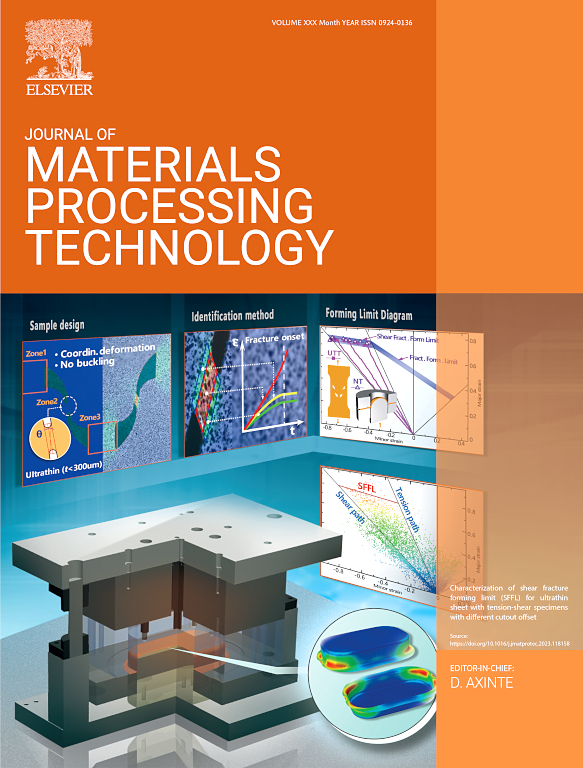通过压力控制焦耳加热和界面变形研究异种薄铜铝棒焊件的新型锻造机制
IF 7.5
2区 材料科学
Q1 ENGINEERING, INDUSTRIAL
Journal of Materials Processing Technology
Pub Date : 2025-07-21
DOI:10.1016/j.jmatprotec.2025.118992
引用次数: 0
摘要
压力控制焦耳加热和界面变形的新机制为锻造高强度铝铜焊接件提供了一条途径,这对电气连接和放电系统至关重要。然而,尽管它们重量轻、刚性好、导电性高,但熔点、热膨胀和强度的差异往往会阻碍有效连接。本研究研究了5 mm薄铝铜棒在控制温度下的塑性屈服,同时保持高强度粘合的压力。利用电伺服压力机和气动控制的可伸缩锥形空心半圆铜电极,建立了一种新的实验装置,用于界面塑性流动的局部加热和定压机械位移。基于有限元的耦合电-热和动态力学模拟评估了驱动界面应变和变形的瞬态热流、热梯度和塑性应力。结果表明,在25 ~ 40 MPa的压力作用下,高强度焊缝(113 ~ 155 MPa)在2 ~ 4.6的界面塑性应变下形成薄的金属间层(0.114 ~ 0.176 μm)。外部模具外壳增强接触和应变集中。此外,还对轴向电流放电下的连接行为进行了研究和比较。低温塑性变形下,铜和铝焊缝界面均通过动态再结晶发生晶粒细化,焊缝显微硬度略有提高。计算结果表明,在较高压力和较小行程的焊接过程中,较低的温升意味着高强度焊缝的均匀界面屈服,增强了对工业应用锻造机制的理解。本文章由计算机程序翻译,如有差异,请以英文原文为准。
Investigating novel forging mechanisms for thin dissimilar copper-aluminum rod weldments via pressure-controlled Joule-heating and interfacial deformation
The novel mechanism of pressure-controlled Joule heating and interfacial deformation offers a route to forging high-strength aluminum-copper weldments, crucial for electrical connections and discharge systems. However, despite their lightweight, rigidity, and high conductivity, differences in melting points, thermal expansion, and strength often hinder effective joining. This study investigates plastic yielding at a controlled temperature while maintaining pressure for high-strength bonding in 5 mm thin aluminum copper rods. A novel experimental setup is developed using an electro-servo press and pneumatically controlled retractable tapered hollow semi-circular copper electrodes for localized heating and mechanical displacement at set pressure for interfacial plastic flow. Finite element-based coupled electric-thermal and dynamic mechanical simulations evaluated the transient heat flux, thermal gradients, and plastic stress that drive the interfacial strain and deformation. Computed and measured results reveal high-strength welds (113–155 MPa) with 2–4.6 interfacial plastic strain, forming thin (0.114–0.176 μm) intermetallic layers under 25–40 MPa applied pressure. The external die enclosures enhance contact and strain concentration. Additionally, the joining behavior under the axial current discharge are investigated and compared. Both copper and aluminum weld interfaces undergo grain refinement via dynamic recrystallization under low-temperature plastic deformation, slightly increasing weld microhardness. Computed lower temperature increment during welding at higher pressure and smaller stroke implies homogeneous interfacial yielding for high-strength welds, enhancing the understanding of forging mechanisms for industrial applications.
求助全文
通过发布文献求助,成功后即可免费获取论文全文。
去求助
来源期刊

Journal of Materials Processing Technology
工程技术-材料科学:综合
CiteScore
12.60
自引率
4.80%
发文量
403
审稿时长
29 days
期刊介绍:
The Journal of Materials Processing Technology covers the processing techniques used in manufacturing components from metals and other materials. The journal aims to publish full research papers of original, significant and rigorous work and so to contribute to increased production efficiency and improved component performance.
Areas of interest to the journal include:
• Casting, forming and machining
• Additive processing and joining technologies
• The evolution of material properties under the specific conditions met in manufacturing processes
• Surface engineering when it relates specifically to a manufacturing process
• Design and behavior of equipment and tools.
 求助内容:
求助内容: 应助结果提醒方式:
应助结果提醒方式:


